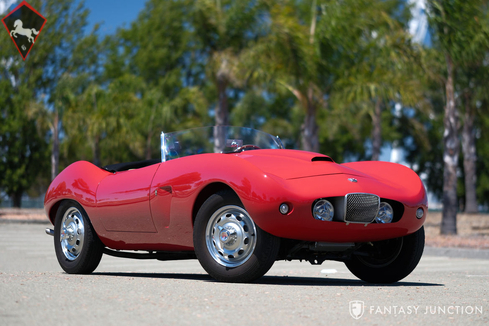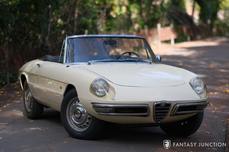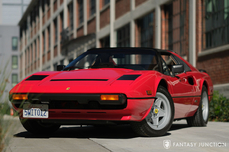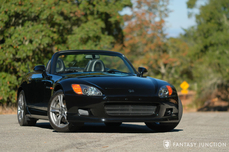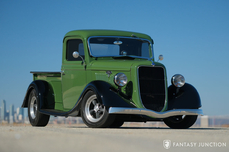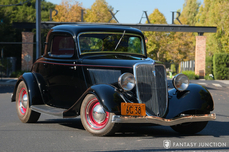Arnolt-Bristol Roadster 2L inline 6-cylinder 1954
Allgemeine Beschreibung :
1954 Arnolt-Bristol Bolide Roadster
Chassis No. - 404X3073
Engine No. - Mk II 274
Red with Tan Leather Interior
One of the earliest Anglo-American mergers of international motoring, Arnolt-Bristol was the result of American, Italian, and English collaboration. Stanley “Wacky” Arnolt, an innovative American enthusiast, industrialist, and businessman, leveraged his US-based MG distributorship with Italian coachbuilder Bertone to build 200 special bodies for the MG TD chassis, creating the MG Arnolt. Though the MG run never concluded, the team pivoted with Bertone to a shortened 404 Bristol chassis, powered by the former BMW Bristol inline-6. A key element to the success of this new venture was the gorgeous hand formed roadster body penned by aerodynamicist/designer Franco Scaglione, who also penned the Bertone B.A.T. cars among numerous important cars from this prolific period. Available in competition “stripped” road race “Bolide” and more road-going Deluxe versions, the Arnolt-Bristol was welcomed by automotive press and enthusiasts as a formidable combination of performance and style. Having completed enough production examples built by 1955, the Arnolt-Bristol was homologated with the FIAA as a limited series production sports car. Arnolt-Bristols raced extensively throughout the late 1950’s and early 60’s with considerable success. During this period, Arnolt retained three cars to use as factory Bolide works racers. In 1955 Wacky Arnolt drafted Rene Dreyfus to be driver and team captain for the Arnolt racing team. Their first race at the Sebring 12 Hour Race resulted in finishing first, second, and fourth in the Sports 2000 class, winning the Team Trophy. In his autobiography, Dreyfus described the Arnolt as “a joy to drive”. The team would go on to repeat this in 1956 and 1960. Historians of the marque indicate that approximately 142 examples were built, a handful of which were lost in a factory fire. Though few are known today, fewer still are factory Bolide models.
This example was purchased by the father of the original owner family, Dan Holland. After a two-day negotiation, Holland purchased 3073 directly from Stan Arnolt in Warsaw, IN and proceeded to drive it to his home in Los Altos, California. He must have made an impressive presence with this rare car crossing half of America in the mid 1950s amidst the large American cars on highways and side roads. Holland was a maven for documentation on his Bolide, sending and retaining numerous letters to Arnolt and Bristol, retaining all returned Arnolt company correspondences and period documentation including the original purchase invoice, all of which support the history of this car from delivery. Letters cover the purchase of spare parts, advice on specifications, a letter from Isky Cams specifying the camshaft they might supply for the Bolide, camshaft grind specs from Bristol (1962), and invoices for engine and exhaust parts purchases. Additionally, local northern California service invoices dating back to the 1960s are also on file with the car.
The Holland family retained the car until late 2017 when it was sold by Fantasy Junction to the current owners who commissioned a cost no object restoration performed by renowned Bristol UK experts in coachwork, interior trim, and mechanical rebuilds for the engine, gearbox, suspension, and brake system. The lead on the restoration is regarded as one of four premier specialists on 2-liter Bristols, as recognized by the Bristol Owners Heritage Trust and recommended by the long-standing President of the Bristol Owners Club. During the restoration the matching numbers engine block and head was rebuilt including machining and balancing using new Cosworth pistons, new unleaded valves, a fresh set of connecting rods, new valve springs, new camshaft and cam followers, and a tuned exhaust manifold. The block, crank, rods, pulley, and flywheel were all machined and balanced. Engine experts at Stanton Motorsports (providing service to Nick Mason’s GTO and other significant performance cars in the UK) determined the historical porting performed under original ownership to have been well done so this was not altered, rather only cleaned during the rebuild. The gearbox was also comprehensively rebuilt including new synchros and the installation of a Laycock de Normanville overdrive with remote gearshift. Importantly, the gearbox was built with a fixed non-synchro 1st gear, which is a superior alternative to the often-troublesome freewheeling first gear frequently found on Bristol gearboxes. The restoration spanned December 2017-June 2019 when it returned to San Francisco, CA. Between 2021 and 2023, ongoing mechanical services have been provided by Burlingame Motors including refinement to mechanical systems, fluid changes, gasket changes, and electrical wiring adjustments/replacement as typically experienced during post-restoration sorting. During the restoration sorting process, the speedometer was replaced with a zeroed out new old stock speedometer which today indicates approximately 79 miles. The current owner reports that since the restoration was completed, they have driven the car approximately 2,000 miles consisting of local drives, two trips to Monterey, Ca, and a drive up the pacific coast to San Francisco.
Today this Arnolt-Bristol Bolide presents in beautiful condition with excellent red paint and overall cosmetics that represent the unique Scaglione/Bertone body design with beauty and authenticity. The vivid red finish is not only highly lustrous and smooth, the body surfaces and contours are accurately executed. The passenger side of the front fender top surface alongside the hood has a small stress crack in the finish where the hood fits to the body. The distinctive grille, inboard headlights, and central hood scoop deliver a daring front end which crowns at the center of the cowl, uniquely so in this advanced design. During the restoration a set of 16 x 4J Borrani knock-off center hub wheels with chrome plated triple-ear Arnolt branded knock offs were installed and fitted with Avon tires. Although the original wheels and wheel covers are included as spares, these rare and sporty knock-off wheels add a fantastic competition touch to the Bolide history. The low-profile windscreen, roadster configuration, and lack or distracting chrome or exterior trim make for a truly spectacular statement of purity in design and competition preparation.
The interior has been accurately finished with attention to detail befitting a car of this rarity and status. The dashboard is finished in matching body color red featuring an array of large and smaller diameter Smiths gauges, switches, and toggles for various features. The clock, updated to electric internals, is a working unit but intentionally disconnected to avoid voltage draw when not in use. Though the interior is spartan by necessity, details still please the eye including a wood rim steering wheel, delicate dual side view and central rear-view mirrors, contoured bucket seats with modern competition lap belts, lightened door construction with inner material lining, delicate leather door pulls, fluted rubber mats, and an exposed central cast alloy gearbox armature extending into the central tunnel. The trunk is also lined with fluted rubber mat, contains a full sized Borrani spare wheel and tire, and a convenient storage compartment with hinged lid for easy access to tools or jacking hardware.
Under the hood, the Bristol branded engine retains the Bristol ID plate with the number 274 stamped on the brass engine plate which matches the engine number stamped into the casting base at two separate and matching locations, as well as the original stamped Arnolt-Bristol ID plate located on the cowl. A second manufacturing plate also bears the chassis and engine number further confirming the original engine and chassis number for this car. The engine has been faithfully restored to a high level complete with three original Ruddspeed Worthing branded “Air Straighteners” topping the triple Solex carburetors. These unique and rare performance upgrades were purchased in period by Dan Holland specifically for this engine. Tuned exhaust, correct electrical components, and proper vintage components continue the themes of authenticity and excellence. A modern electric fan has been added to aid in engine cooling.
The underside of the car is exemplary in every respect with excellent and correct finishes, modest updates allowing for modern materials, detailed casting artistry for the engine and gearbox, and excellent finishes throughout. The quality and attention to detail remain among the best one might find should they find the rare occasion to discover another Bolide of this distinction.
The car starts, runs, and drives quite well given the early years of performance development in this series of cars. Though just a small start-up at the time, the Arnolt-Bristol was a very properly resolved car that would impress even the most seasoned sports car enthusiast once at the wheel. Victories at Sebring and other grueling venues were hallmarks of their achievements, much of which is evident in the raw, captivating experience these cars offer. Driving manners are surprisingly nimble and light, especially with the engine revved up to higher levels under more spirited driving, with the added plus of overdrive to ease highway driving. Fully engaged in the driving experience, it’s easy to see how these cars became darlings of the press as racing victories mounted and interest grew over the beauty and performance combination found in these rare hand-built cars.
Accompanied by a bounty of authentic spares, period documentation, and important accessories, the list includes a set of side curtains and case, the original set of five Bristol factory five-bolt wheels and hubs, seven wheel caps, a spare steering wheel (believed to be the original one for the car), a knock-off mallet, convertible top bows, a vintage set of competition seat belts, spare wiper blades and wiper arms (wipers are not currently fitted on the car), spare engine gaskets, seven spare Arnolt-Bristol molded emblems (one painted), a spare set of headlight trim rings, misc. gauges, a set of tools and tool roll, a workshop manual, Solex carburetor service manual, spares manual, instruction manual, an Arnolt-Bristol brochure, 1964 SCCA specification manual, and other assorted reference materials. Also included are Dan Holland’s original patinated racing gloves and vintage helmet along with a pair of vintage racing goggles.
Eligible for premier vintage racing, world-wide events and rallies, as well as the historical Mille Miglia, this is a rare opportunity to acquire one of the most dramatically designed and engineered sports cars from the golden age of sports car development. Copiously documented, beautifully restored, and accompanied by spares which validate decades of original California ownership and early history, this is an unprecedented Arnolt-Bristol Bolide ready to show and enjoy just as the original long-term owner and current owner have over the past 70 years.
1954 Arnolt-Bristol Roadster 2L inline 6-cylinder is listed zu verkaufen on ClassicDigest in California by Fantasy Junction for Preis nicht verfügbar.
Fakten der Auto
Karosserietyp : Auto Marke : Arnolt-Bristol Modell : Roadster Ausführung : 2L inline 6-cylinder Hubraum : 0.0 Modelljahr : 1954 Lage : Emeryville Fahrzeug Anmeldung : Normal
Preis nicht verfügbar
Angaben Zum Verkäufer
Fantasy Junction
Fantasy Junction
+1 510 653 7555
Fantasy Junction
+1 510 653 7555
Other cars listed for sale by this dealer
über Arnolt-Bristol
Arnolt-Bristol war eine Automobilkooperation zwischen Stanley H. „Wacky“ Arnolt, einem amerikanischen Geschäftsmann, und dem britischen Automobilhersteller Bristol Cars. Die Partnerschaft führte in den 1950er Jahren zur Produktion einer Reihe von Sportwagen. Hier ist ein Überblick über die Geschichte von Arnolt-Bristol, bemerkenswerte Modelle, ihre Spezifikationen und ihren kulturellen Kontext:1. Geschichte: In den frühen 1950er Jahren versuchte Wacky Arnolt, europäische Sportwagen in die Vereinigten Staaten zu importieren. Er ging eine Partnerschaft mit Bristol Cars ein, die Fahrgestelle und Motoren lieferte, während sich die Carrozzeria Bertone in Italien um die Karosserien kümmerte. Das Ergebnis war die Schaffung einzigartiger und stilvoller Sportwagen, die britische Mechanik mit italienischem Design verbanden.
2. Bemerkenswerte Modelle:
- Arnolt-Bristol Bolide: 1953 eingeführt, verfügte er über eine von Bertone entworfene leichte Roadster-Karosserie. Angetrieben wurde er von einem Bristol-Sechszylindermotor, der starke Leistung und Handling bot.
- Arnolt-Bristol Deluxe: Diese Variante verfügte über ein raffinierteres Interieur mit Annehmlichkeiten wie Ledersitzen und einem Cabrioverdeck.
- Arnolt-Bristol-Coupé: Es wurde eine kleine Anzahl von Coupés mit einer eleganten zweitürigen Karosserie und einem festen Dach hergestellt.
3. Spezifikationen: Die Arnolt-Bristol-Wagen wurden typischerweise von Bristols 2,0-Liter-Reihensechszylindermotor angetrieben, der rund 130 PS leistete. Sie zeichneten sich durch Leichtbauweise, Einzelradaufhängung und Allrad-Scheibenbremsen aus, was zu ihrem sportlichen Fahrverhalten beitrug.
4. Kultureller Kontext: Die Arnolt-Bristol-Autos stellten eine Mischung aus amerikanischen, britischen und italienischen Automobileinflüssen dar. Sie sprachen Liebhaber an, die etwas Besonderes und Exklusives suchten. Die Kombination aus britischer Ingenieurskunst und italienischem Stil führte zu auffälligen Designs, die sich von anderen Sportwagen dieser Zeit abhoben. Die Autos galten als exotisch und stilvoll und erregten die Aufmerksamkeit sowohl von Automobilliebhabern als auch der breiten Öffentlichkeit.
Trotz des anfänglichen Erfolgs und der positiven Resonanz war die Produktion von Arnolt-Bristol-Autos mit rund 142 Exemplaren, die zwischen 1953 und 1959 gebaut wurden, relativ begrenzt. Heute gelten diese Autos als selten und hochsammelbar, was ihre einzigartige Mischung aus britischer Ingenieurskunst und italienischem Design widerspiegelt. Sie stellen ein interessantes Kapitel der Automobilgeschichte dar und zeigen die kreative Zusammenarbeit zwischen verschiedenen Ländern und Herstellern in der Mitte des 20. Jahrhunderts.
